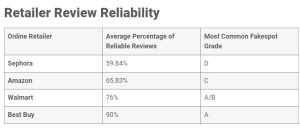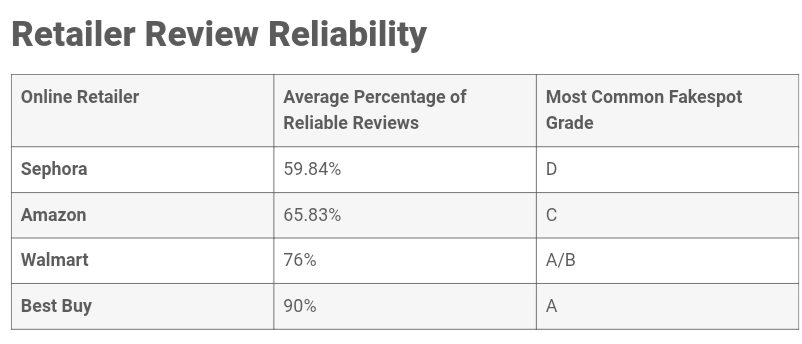The State of Retailer Review Reliability: Insights for a Better Customer Experience
In the fast-evolving e-commerce landscape, online reviews are the lifeblood of customer trust and purchasing decisions. However, the reliability of these reviews varies widely across retailers, often leaving consumers questioning the authenticity of the feedback they rely on. This article delves deep into the review reliability of four prominent online retailers—Sephora, Amazon, Walmart, and Best Buy—analyzing their average percentage of reliable reviews and their most common Fakespot grades to uncover what it means for customer experience (CX).
The Importance of Retailer Review Reliability in CX
Customer reviews serve as a cornerstone for decision-making in online retail. Reliable reviews build trust, influence buying decisions, and strengthen brand reputation. On the flip side, unreliable or fake reviews erode trust and lead to dissatisfaction. Retailers must ensure a transparent and authentic review ecosystem to enhance the overall CX.
Retailer Review Reliability Overview
- Sephora: Beauty with a Trust Gap
Average Reliable Reviews: 59.84%
Most Common Fakespot Grade: D
Sephora, a leader in the beauty retail industry, surprisingly lags in review reliability. With less than 60% of its reviews deemed reliable, customers may struggle to differentiate authentic feedback from potentially manipulated content. A Fakespot grade of D further underscores this concern. For Sephora, addressing this issue is critical to maintaining its image as a trusted source for beauty products.
- Amazon: The E-Commerce Giant with Room for Improvement
Average Reliable Reviews: 65.83%
Most Common Fakespot Grade: C
Amazon’s massive scale and vast product selection make it a go-to platform for many shoppers. However, only 65.83% of its reviews are considered reliable, indicating a significant prevalence of fake or manipulated feedback. A C grade from Fakespot highlights the need for Amazon to enhance its review moderation systems. Given its global reach, improving review authenticity could further solidify Amazon’s dominance in the e-commerce sector.
Performances
- Walmart: A Strong Performer in Review Reliability
Average Reliable Reviews: 76%
Most Common Fakespot Grade: A/B
Walmart emerges as a strong performer, with 76% of its reviews deemed reliable. The retailer’s A/B Fakespot grade reflects a proactive approach to maintaining authenticity. This reliability likely contributes to Walmart’s ability to compete with online giants like Amazon. By continuing to prioritize authentic customer feedback, Walmart can further improve CX and foster customer loyalty.
- Best Buy: Leading the Pack in Trustworthiness
Average Reliable Reviews: 90%
Most Common Fakespot Grade: A
Best Buy sets the gold standard for review reliability, with a staggering 90% of reviews being authentic and a consistent A grade from Fakespot. This level of trustworthiness positions Best Buy as a leader in CX, especially in the competitive electronics retail space. Customers shopping at Best Buy can feel confident in their purchasing decisions, knowing that the reviews they read are overwhelmingly genuine.
Analyzing the CX Implications
Customer Trust
Review reliability directly impacts customer trust. Retailers with higher percentages of reliable reviews—like Best Buy and Walmart—build stronger relationships with their customers. Conversely, retailers like Sephora and Amazon risk alienating customers if they don’t address the prevalence of fake reviews.
Purchase Confidence
Reliable reviews enhance purchase confidence by providing customers with accurate product insights. Best Buy’s high review reliability likely contributes to higher customer satisfaction and reduced return rates. For retailers with lower reliability scores, the opposite effect may occur, leading to frustrated customers and increased return rates.
Brand Reputation
Retailers with reliable reviews tend to enjoy a stronger reputation. Best Buy’s leading score reinforces its image as a customer-centric brand. For Sephora and Amazon, improving review reliability could mitigate potential reputational risks and enhance their competitive standing.
Long-Term CX Strategies
Retailers can adopt several strategies to improve review reliability and, by extension, CX:
- Enhanced Moderation Systems: Using AI-driven tools to detect fake reviews and filter them out can significantly improve reliability.
- Verified Purchase Tags: Ensuring that only customers who have purchased a product can leave reviews adds a layer of authenticity.
- Transparency in Review Policies: Clearly communicating how reviews are collected, verified, and moderated builds trust.
- Encouraging Honest Feedback: Retailers can incentivize genuine reviews while discouraging manipulative practices.
The Path Forward for Retailer Review Reliability
Retailers that prioritize review reliability are better positioned to thrive in a competitive market. While Best Buy and Walmart lead the way, Sephora and Amazon have an opportunity to reassess their review systems and implement robust measures to enhance authenticity. In doing so, they can improve customer trust, increase purchase confidence, and create a more reliable shopping experience.

Conclusion
Review reliability is more than just a metric—it’s a cornerstone of customer experience. Retailers that succeed in fostering authentic, trustworthy reviews stand to gain customer loyalty, enhanced reputation, and long-term growth. As the e-commerce landscape continues to evolve, review reliability will remain a critical factor in shaping the future of CX. Retailers must take proactive steps to ensure that their reviews reflect genuine customer experiences, building trust and satisfaction across their customer base.

